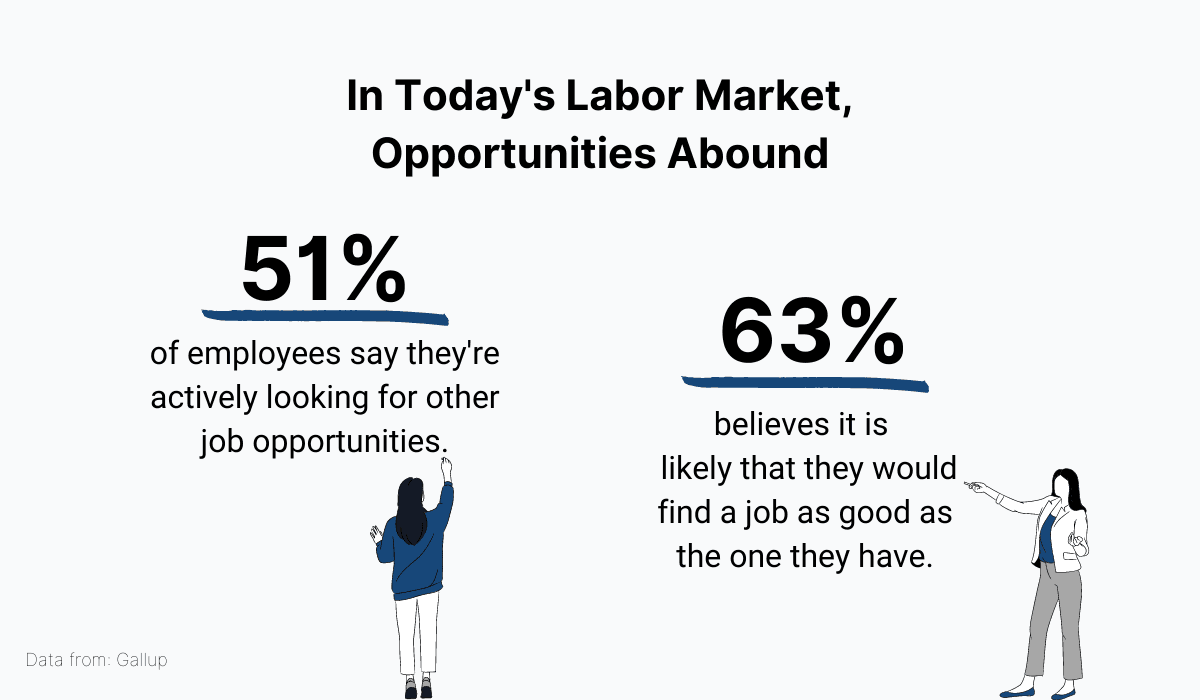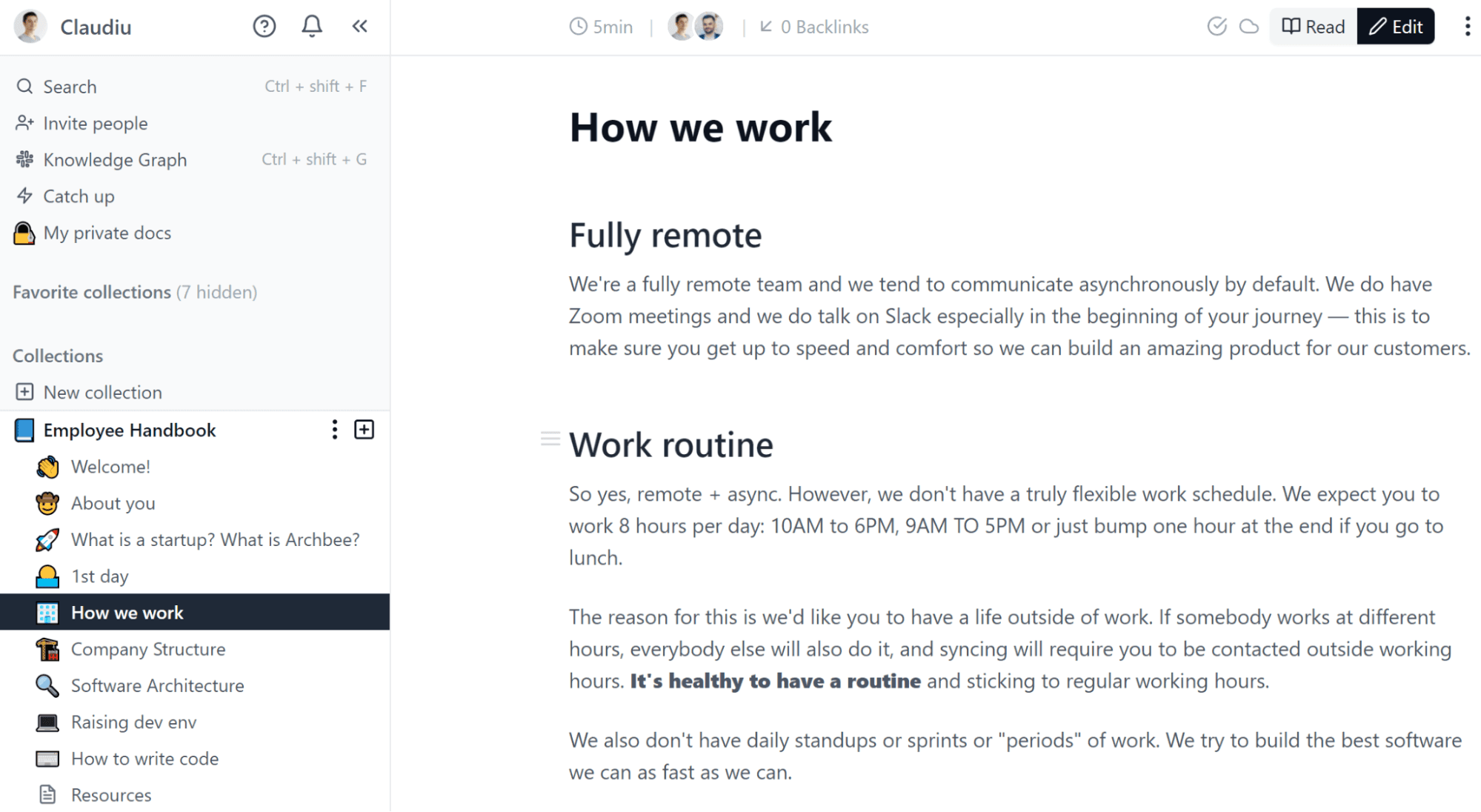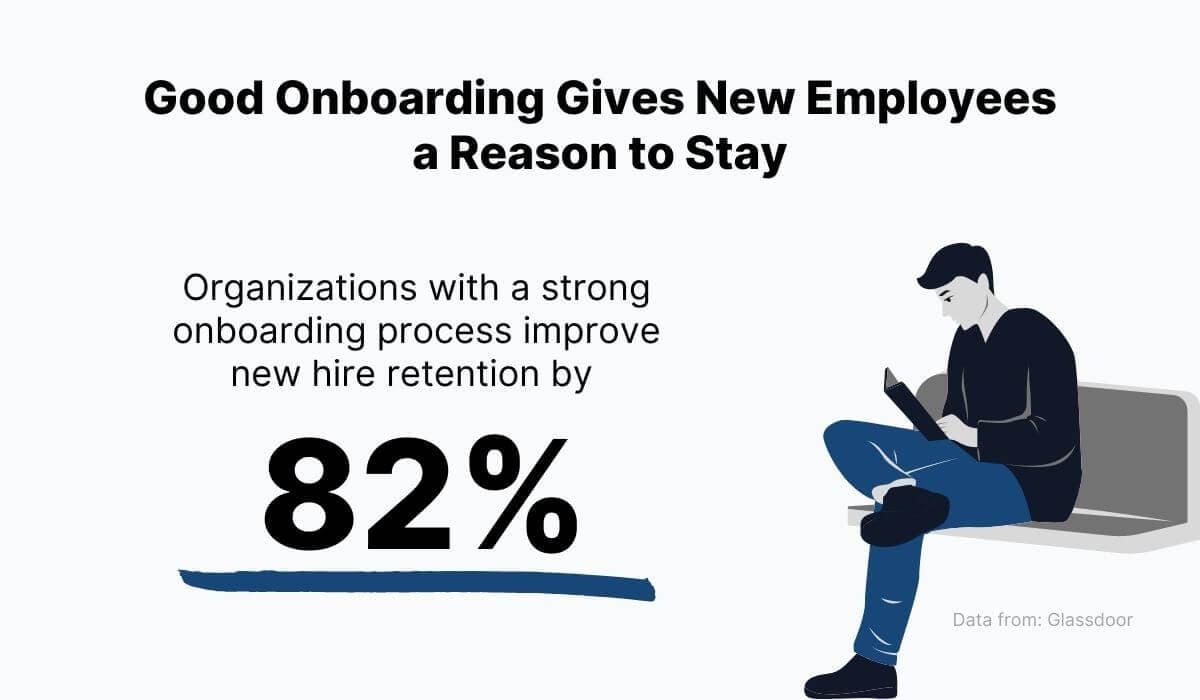Too many leaders and managers still consider showing new employees the basics of their role and then leaving them to their own devices to be the ultimate goal of onboarding.
But that’s not onboarding; that’s orientation. Where does culture fit into that equation? Or employee engagement? How about an employee retention strategy?
Without a well-thought-out onboarding program that aims to provide your new employees with the best employee experience possible, you’re putting your company at risk for disengagement, high turnover, and subpar performance.
Have no fear, though. We’re here to help.
This article will provide you with knowledge on the essential goals every employee onboarding program should achieve to best serve your company, as well as your new employees. And it all starts with a great first impression.
Leaving a Great First Impression
You may have heard about some of the extravagant and lavish practices famous companies employ to wow their employees on their first day.
From a decorated desk and lunch with the executives to the latest tech and a plane ticket to visit the company headquarters, new employees of the modern corporate landscape have much to look forward to on their first day.

Source: Medium
Welcome gifts, company swag, and new employee perks are becoming so generous that it’s completely natural to ask, “isn’t all of that a bit much?”
As it turns out, the answer is: no, not at all.
Quality hires are increasingly difficult to find, as well as retain.
A far cry from recession times, today’s workers are always keeping an eye out for favorable employment opportunities, assessing that the likelihood of finding a new job at their current level is very high.

Source: Archbee.com
In these circumstances, keeping employees satisfied has become more important than ever, and it all starts with the onboarding process.
How you welcome new employees and how you handle onboarding is incredibly important. After all, it’s your only chance to leave a good first impression on your employees.
Therefore, one of the key functions of your onboarding process is to help your new employee validate their decision to accept a job offer from your company.
If your company isn’t able to inspire the confidence in your new hire that they’ve made the right choice in choosing your company, you might risk losing them very quickly after they start working for you.
This is something many companies still don’t pay enough attention to, as evidenced by the fact that a fifth of employee turnover happens within the first 45 days of employment.

Source: Archbee.com
Apart from causing you to lose valuable talent, high turnover rates also have the potential to seriously harm the economic health of your company, so you should take action to keep turnover as low as possible.
But making a good impression isn’t just about retention rates.
Keep in mind that new employees share their experiences with their social circle.
If you don’t provide a good onboarding experience, you might be putting your company’s reputation in peril, as research shows that 1 in 5 employees say they wouldn’t recommend working at their company to others after they went through onboarding.
Conversely, an engaging, content-rich onboarding process could do much to help you attract new talented individuals to apply for your open positions.
All in all, you can definitely consider your onboarding process to be instrumental in forming the first impression with your new employee.
We don’t get a second chance at first impressions, so do what you can to wow your new hires from the very start.
Introducing the New Hire to the Company
Another important function of your onboarding process is to introduce your new employees to your company and the unique way you like to do things.
This is your opportunity to showcase your great products and demonstrate your workflows so that the employee can internalize the value you’re creating and learn to do things your way.
After all, how can your employees sell your products if they don’t have a thorough knowledge of them? How can they help customers if they themselves aren’t sure how your company does business?
Therefore, as you’re welcoming new employees, make sure you’re enabling them to find out everything there is to know about the company they’re going to be working for.
A company that does this very well is Under Armour.
At this company, new employees act as beta testers for new products, such as their training app, Under Armour Connected Fitness.

Source: Under Armour Connected Fitness
The Beta coordinator at the company, Michelle Mitchell, says that this helps build a “testing culture” at Under Armour, so that the team can collectively catch mistakes early on and get comfortable with sharing feedback often.
But aside from benefiting your products, this is an excellent way to introduce new hires to your line of products.
They can view them from the perspective of consumers, which helps with providing excellent customer service.
It’s also a great way to show, rather than tell, your new hires what the production process actually looks like.
Aside from concrete aspects of your work, employees also need to be exposed to the essential rules that govern your company’s day-to-day operations.
These can usually be found in company documents, such as company policy, code of conduct, and employee handbooks, which are a part of your company’s knowledge base.

Source: Archbee.com
Of course, these important documents cannot be absorbed in a one-time learning event, but should rather be available to the new employee at all times. That way, they can consult them whenever they need to.
The new trend many companies follow is to house this critical information inside quality software documentation so that all employees can access it at all times.

Source: Archbee.com
With documentation software, such as Archbee, all you need to do is provide your new employees with the login information to your knowledge base.
You can rest assured that they will be able to find every rule, procedure, and policy they need for their work there.
Introducing new hires to your company is a crucial onboarding step, but it doesn’t require as much of your attention as you may think.
In many cases, it’s enough to give your capable new team members access to the things they need to tackle their tasks and allow them to acquaint themselves with the specifics of your company on their own.
Integrating the New Employee Into the Company Structure
Apart from understanding the foundations your company has been built on, your new employees also need to understand its structure and how their new role ties into it.
With a deep understanding of the key positions, departments, and functions in the company, your new employee has a better chance to integrate effectively.
Your company, especially if it’s a larger enterprise, comprises several structural levels that new recruits should become familiar with and learn how they interact with one another.

Source: Archbee.com
Therefore, one of the goals of onboarding should be to teach the new employee the ins and outs of their own role, but also to expose them to what other departments are doing.
That way, they have a better chance of contributing to company goals on their own, but also of collaborating with other teams and individuals in the company.
This should clearly be a very social component to the onboarding process, where the new hire meets other team members, department heads, and executives who can tell them more about the company mission.
But some companies go even further than that and employ job rotation programs, where new hires actually get to experience what it’s like working in departments other than their own.
For example, the Dutch beer brewer Heineken, whose HR campaign is aptly named “Go places”, has an interesting technologist onboarding program that uses a similar method.

Source: Ads of the World
The most promising trainees are put on six-month assignments in different departments, such as package design, brewing, quality assurance, and product development.
At the end of this intense training program, employees take up their positions as technologists in various departments, having amassed a diverse set of skills and first-hand knowledge of the company’s structure and how their role fits into it.
Heineken does an excellent job with integrating new recruits into the company structure, but you don’t need to go to such lengths to accomplish the same results.
Just make sure the new employee has enough interaction with the key players at your company and allow them to socialize and collaborate with members of other departments.
All of this, of course, should be done in tandem with a training program introducing the employee to the intricacies of their individual role in the company.
Immersing The New Hire Into the Company Culture
The next vital goal is quite similar, but instead of inducting the new employee into abstract structures and processes, it connects them to the most valuable resource your company has—people.
It’s hard to quantify just how crucial a vibrant and rich company culture is for an organization to succeed. However, we will say that both job seekers and entrepreneurs consider it essential.

Source: Archbee.com
Your company culture is the glue that holds your company together. It’s the ethos that brings everyone to the same page, making collaboration between employees, teams, and whole departments easier.
Clearly, culture plays a vital role in your success, meaning employees should be made part of it as soon as they step through the door.
Even sooner, actually. Finding a cultural fit should also be a part of your hiring strategy. You should be looking for candidates who share your values and display personal characteristics you consider desirable.
Once the perfect candidate becomes a fresh recruit and onboarding officially starts, you can engage them in activities designed to immerse them into the culture of your company.
That can mean transferring knowledge about your history and values but also allowing the recruit to interact with other people at the company as much as possible.
For example, the company JAMF, which offers management software for Apple’s ecosystem, does both very successfully.
Their onboarding program carries the name “Zero Month”, a period when, among other things, new hires learn everything there is to know about the company’s history and culture.
However, instead of watching onboarding videos and reading materials, new hires learn all of this through a series of conversations with executives and high management personnel.
✅ Intensive learning and immersion into company culture? Check.
✅ Creating opportunities for interaction with key faces at the company? Also check.
JAMF puts culture in the center of the onboarding process, which, admittedly, puts pressure on their resources, but they see a return on their investment very quickly.
Today, the company boasts incredibly high employee retention rates, as well as a very happy customer base.

Source: LinkedIn
The key takeaway here is that culture needs to be a priority for your company. And if that’s true, then it’s also true that culture needs to be at the center of your onboarding process goals.
Engaging the New Hire
One of the basic rules of human psychology is that we feel anxious, disengaged, and inadequate when we’re given a task that we don’t understand or aren’t equipped to handle.
This holds especially true in the context of work.
When you put in enough time and effort to onboard your employees, you stand to see your overall performance skyrocket.
That’s because every employee has the knowledge and tools to do their best work, which means they can engage with their tasks in meaningful ways.

Source: Archbee.com
An excellent practice to follow here is to find a way to get your new hire to their first win as soon as possible.
That way, the new employee can start feeling confident, engaged, and included even during the onboarding process.
That’s what the team at Hypercontext, the meeting software provider, does. For new developers at the company, that can mean submitting their first pull request.
On the marketing side, it might be writing and publishing the first blog post.
Hiba Amin, senior marketing manager at the company, knows how important inspiring confidence is for new employee engagement:
Giving new employees their first win, fast, means that we're able to build their confidence and make them feel like contributing members of the team within their first two weeks on the job.
It’s not just about providing the tools for work, though. All employees, but new hires especially, need encouragement and feedback to know that they’re doing a good job.
Therefore, onboarding also needs to allow for meaningful discussions about the employee’s progress and the quality of their work.
Even just a kind word here and there will renew your employees’ dedication to their job and motivate them to reach their full potential.
An excellent example of a company nailing employee engagement comes from the legal services company, Legal Monkeys.
They introduced an “appreciation board”, a small glass picture frame where employees can write messages of appreciation to their colleagues to tell them they’re nice to have around or that they’re doing stellar work.
Check it out:
The great thing about this is that it’s cheap and easy to apply. It also doesn’t get in the way of work.
Also, this is a great example of coworkers showing appreciation to each other, which works wonders for building team spirit.
An engaged workforce means that you’re succeeding in your employee training and induction efforts, so you should definitely count engagement at work as an explicit goal for your onboarding process.
Retaining the New Hire
Retaining the new hire is the ultimate goal every onboarding program should strive to achieve.
Employee turnover is a normal occurrence in any company. However, a turnover rate spinning out of control is incredibly harmful, and can incur high costs.

Source: Archbee.com
A good employee retention strategy always starts with the onboarding process. This period is when you build the foundations for an excellent employee experience at your company.
You’re transferring essential knowledge, developing key skills, and creating opportunities for new employees to form strong relationships with their coworkers.
With a good onboarding program, employees form strong ties with the company that are hard to sever later. That’s why quality onboarding is proven to result in elevated retention rates.

Source: Archbee.com
The key to connecting onboarding to employee retention is to train your employees for the long haul.
Don’t just train them to do the bare minimum. Give them the tools and the voice to influence the work processes at your company and make them their own.
That’s what the hotel company, Hyatt, does. Their housekeeping training program bears the interesting name “Change the Conversation” and it really flips the script on onboarding as we know it.
The main principle of the program is to allow employees to find their own solutions to everyday tasks and apply their own best practices in their work, instead of distributing training top-down.
That way, workers become owners of Hyatts workflows, which gives them a stake in the company and enables them to carry out their work in the way they’re most comfortable with.

Source: Hotel Jobs Asia
The results are astounding.
The average member of the housekeeping team at Hyatt stays with the company for 12 years.
Overall, 4,000 of Hyatt’s approximately 75,000 employees in the US have stayed with the company for more than ten years.
The lesson here is that onboarding should mean empowerment.
Employees who have a sense of ownership over the working process and the power to influence how things are done in their team will naturally want to retain their job at a company they see as their own.
Employee Onboarding Goals: A Summation
If we were to summarize this entire article in a couple of words, they would be: “Always provide the best experience possible!”
Your onboarding process isn’t about your company. It’s about your employees.
Therefore, the goals of your onboarding process should serve your employees first and foremost.
Trust us—optimal performance, business growth, and progress on your company mission are sure to follow.
FAQ
Frequently Asked Questions
Orientation is a short, one-time introduction to the basics—think paperwork, policies, a tour, and getting your laptop set up. It typically lasts a day or two. Onboarding is a longer, structured journey (weeks to months) that helps a new hire become confident, productive, and connected. It includes role training, clear goals (often 30/60/90 plans), access to knowledge and tools, regular check-ins and feedback, introductions to key people, and immersion in the company’s culture and ways of working. In short: orientation gets you in the door; onboarding helps you thrive.



